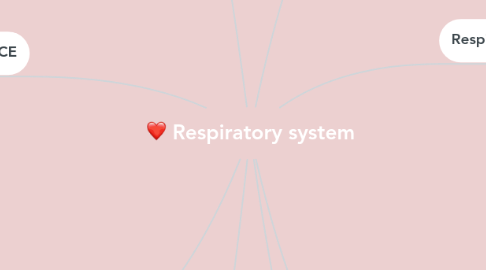
1. RESPIRATORY SURFACE
1.1. 1.Must be Moist for gas exchange 2.Gas exchange by diffusion 3. Skin, Gills , trachea , alveolus
1.2. GILLS Out folding of the body that create large surfce area for gas exchange 1.Marine Worm Have a pair of flattened appendages called parapodia serve as gills also functioning in crawling and swimming 2.Cray fish Long feathery gills covered by the exoskeleton.Specialized body appendages drive water over the gills. 3.Sea star Simple tubular projections of the skin,the hollow core of each gill is an extension of the coelem(body cavity) Gas exchange occur by difussion across gill surfaces and fluid in the ceolem circulates in and out of the gills aiding in gas transport
1.3. TRACHEAL SYSTEM 1. Consist of tiny branching tube penetrate the body. 2 Supply O2 direct to the body cell 3.Respiratory and circulatory system separated 4. Larger insect must ventilate their tracheal system to meet O2 demand.
1.4. Amphibian Breathing 1. Ventilates it lungs by + pressure breathing. 2. No diaphragm need to force air into lungs. INHALATION 1. Muscle lower the floor of oral cavity, drawing air to nostrills 2. Nostrills and mouth closed floor of oral cavity rise air is forced down the trachea. EXHALATION 1.Compression of muscular body forces air back out the lungs.
2. RESPIRATORY SURFACE
2.1. BIRD BREATHING 1. Eight or nine air sacs to keep air flowing to the lungs 2. Air pass through the lungs in 1 direction, fresh air does not mix with air that has already carried out gas exchange . 3.Every exhalation completely renews the air in lungs
3. MAMALIAN RESPIRATORY SYSTEM
3.1. 1. Branching ducts convey air to lungs
3.2. 2. Air inhaled is warmed, humidified and sample for odor
3.3. 3. Pharynx direct air to lungs and food to stomach
3.4. 4.Swallowing tips the epiglottis over the glottis in the pharynx to prevent food from entering the trachea.
4. Lungs
4.1. Breathing measurement
4.1.1. 1.Tidal Volume (breath at rest ) 500 ml 2. Vital capacity/inspiratory reserve volume. maximal inhalation and exhalation 3.4 L in woman 4.8 L in man 3. Residual volume the amount of air that remains in the lungs after forced exhalation
4.2. Control breahing in human
4.2.1. .Main breathing control centre is at medulla oblongata and pons.
4.2.1.1. medulla regulates rate and depth breathing in response to change in pH IN CEREBROSPINAL FLUID to match metabollic demands.
4.2.2. Sensors in aorta and carotid artery monitor O2 and CO2 exert as 2nd control over breathing.
4.3. human lungs
4.3.1. pharynx -- larynx -- trachea -- bronchi -- bronchioles -- alveoli
4.3.2. exhaled air pass over vocal cord in the larynx to create sound
4.3.3. CILIA, MUCUS move particles up to pharynx
4.3.4. mucus escalator clear the respiratory track and swallowed to esophagus
4.3.5. ventilates lungs by negative pressure brething
4.3.5.1. inhalation -lungs vol increase, rib muscle,diaphragm contract. -air pressure in lungs is lower than air outside body - Air rush thru nostrills and mouth down the breathing tube to alveoli
4.3.5.2. exhalation -lung vol reduce,rib and diaphragm relax -pressure in alveoli increase forces air out from the body -inhaltion requires work, exhalation passive
5. P.P GRADIENTS IN GAS EXCHANGE
5.1. Gas diffueses from a region of higher partial pressure to region of lower partial pressure.
6. Respiratory media
6.1. 1. Air 2. Water
6.1.1. Advantages of Air 1.High concentration of O2 than water 2.Less energy require for ventilation Dissadvantage of air 1 Dries out the respiratory surface
6.1.2. Advantages of Water 1. No problems keeping the cell membrane Moist Dissadvantages of water 1. [O2] LOW
7. 5 CHARACTERISTIC OF MAMALIAN RESPIRATORY SURFACES
7.1. 1. Must be PERMEABLE
7.2. 2. 1 cell thick,Must be thin (1mm or less)
7.2.1. gas exchange take place in alveoli

